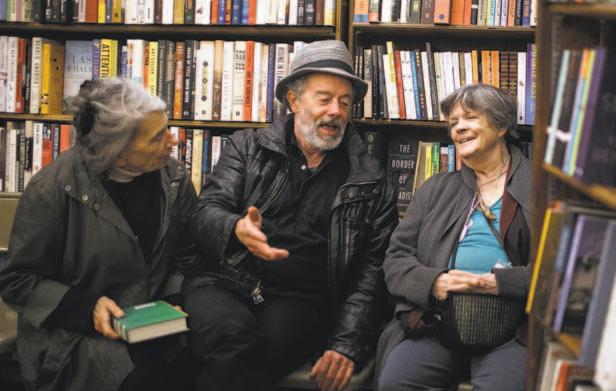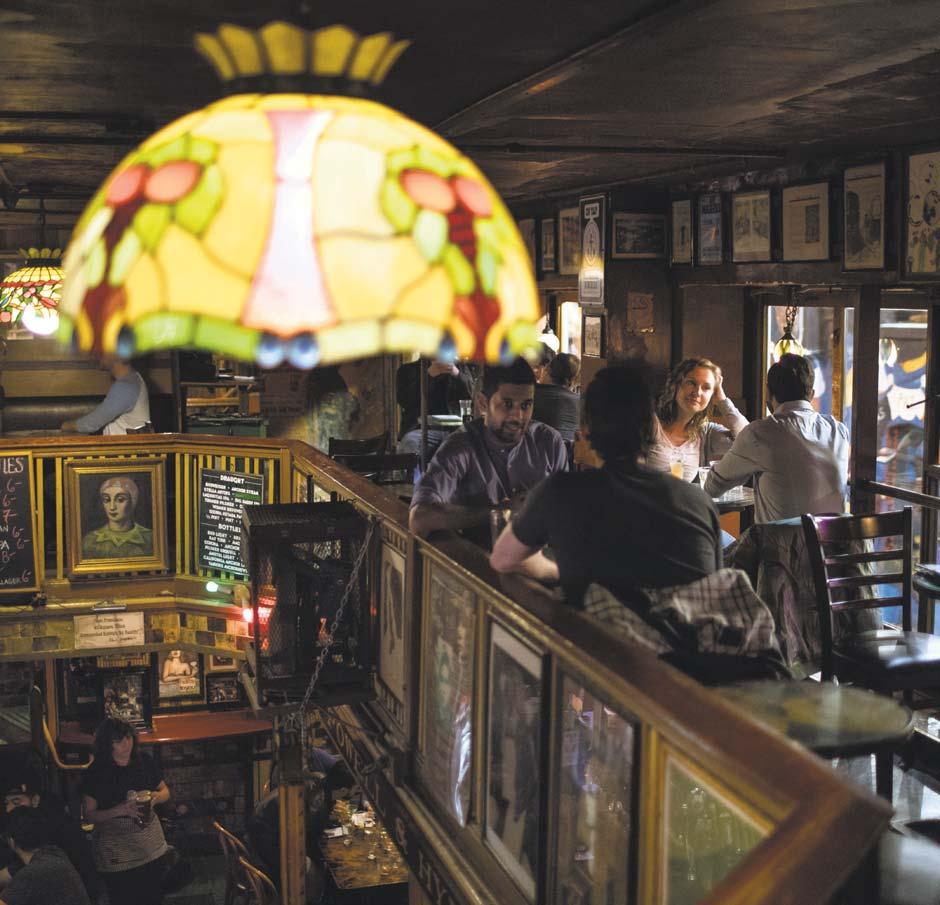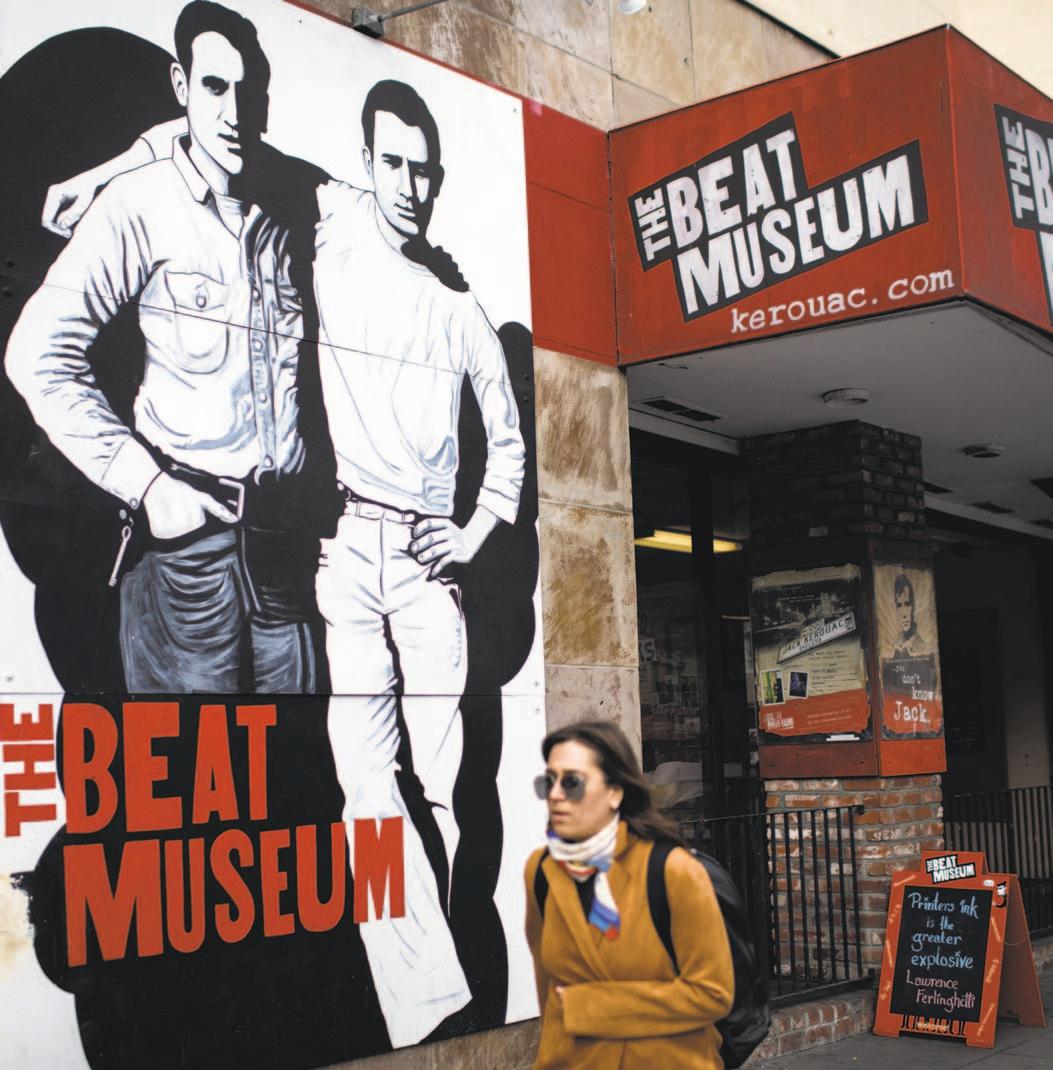
4 minute read
The beat goes on for Kerouac and company hangouts
STORY BY TOM BENTLEY PHOTOS BY DAI SUGANO/STAFF
n the 1970s, because I’m that kind of a guy, I hitchhiked barefoot from L.A. to Seattle. Because I didn’t bring along any of my size 13 shoes, I was traveling light. But like many hairy tramps in those days, I did bring Jack Kerouac’s “On the Road.” Back then, the book felt like an anthem to freedom, friendship and the open road — and I was among the hordes that fell under its words-spillingover-a-cliff spell.
A posse of the original Beats — Allen Ginsberg, Neal Cassady, Gregory Corso, William Burroughs and Kerouac — met in New York in the ‘40s, and most of them made their winding ways west to San Francisco. Kerouac’s crisscrossing drives across the country, often with the frenetic Cassady behind the wheel, form the pumping heart of “On the Road.”
In the West, the open, permissive atmosphere of San Francisco melded well with the exploratory, rejectors-of-convention Beats, who were pouring out as much poetry and tale-telling as they were jug wine.
The later ‘50s saw the publication of Ginsberg’s epic poem “Howl,” for which publisher Lawrence Ferlinghetti was arrested on obscenity charges. A few years before the poem’s debut, Ferlinghetti had started City Lights Publishers, which made a fine outlet for the Beat works that later filled the shelves of his landmark City Lights Bookstore. The pulse of the Beats thrummed, with writers like Gary Snyder, Michael McClure and Philip Whalen infusing new blood.
Ferlinghetti turned 100 in March, and part of the celebration was the release of his new autobi- ographical novel, “Little Boy.” Perhaps not surprisingly, a number of the San Francisco Beat hangouts are almost as venerable as Ferlinghetti. Those guys couldn’t live by words alone — booze and coffee had to fuel many of their mad metaphors. In the North Beach area where their words resonated, the joints where the beats wined and dined are still bopping; stroll around, and maybe you can even get a bite of “Naked Lunch.” But if you’re going to make a personal “On the Road” trip to see all things Beat, don’t do it barefoot. The streets of San Francisco can bite back.
Beat Bastions
CITY LIGHTS BOOKSTORE


Saying something is an institution damns it in some way, suggesting an arthritic edifice. Not so for City Lights, which remains vibrant, quirky and bookish in the best of ways. Salute the first bookstore in the country to sell only paperback books and its standing as an incubator of progressive — if not transgressive — thought. And the spiritual home, a veritable Coney Island of the Mind, of one L. Ferlinghetti, who at 100 isn’t an institution, but more of a beacon. He still glows.
Be sure to take a peek at the plaques and artwork that adorn Jack Kerouac Alley, which flanks the store.
Details: Open daily from 10 a.m. to midnight at 261 Columbus Ave. at Broadway, San Francisco; www. citylights.com.
Vesuvio
Asaloon in the most appealing of senses. Built in ‘48, and still great. There are lots of photos of Beat luminaries and eye-popping art. These are digs where “diverse crowd” doesn’t mean “has a tattoo.” Don’t forget the booze — none of the Beats did. Have a tot and knock on the walls. You might hear a story whispered back at you.
Details: Open daily from 8 a.m. to 2 a.m. at 255 Columbus Ave.; www.vesuvio.com.
A Tiffany lamp casts a muted glow on a dark corner of Vesuvio’s, above, and longtime customer Winston Smith enjoys a cocktail, right.


The Beat Museum

The Library of Alexandria of the Beats, the Beat Museum houses scads of period memorabilia, original manuscripts, photos and personal effects of our favorite bohemian hedonists. Jerry Cimino, the museum’s founder, says, “The motto of The Beats seemed to be: ‘We don’t care who you are, what you look like or what you’re into, as long as you’re not hurting anyone else, come join our party.’ Bottom line, our entire focus nets down to helping people realize it’s OK to live an authentic life and to truly be who they are and want to be.”
The Museum’s served up the legacy of the Beats since 2003, but an upcoming earthquake retrofit has them uncertain of the museum’s future, and even where they will house the extensive collection of artifacts while the retrofit is ongoing. As Cimino says, “My number-one priority is to keep The Beat Museum alive in some way, shape or form. My greatest desire is to remain in the city of San Francisco in an updated and expanded facility.” Check out their site, make a donation and keep the Beats alive.
A “Lawrence Ferlinghetti: Live” photo exhibit by Chris Felver runs through June 30.
Details: Admission is $8 for adults, $5 for students and seniors. Open from 10 a.m. to 7 p.m. daily at 540 Broadway; www. kerouac.com.
Tosca Cafe
Even the drinks at Tosca have atmosphere — the place practically drips it. Tosca’s almost as old as Ferlinghetti, but it’s probably had more work. But the 2013 renovation, which included restoring those redleather booths and opening a kitchen that had been shuttered since 1953, was respectful of Tosca’s good bones. The beer-andshot Beats would have sneered at the notion of today’s mixology, but the discussion would have prompted another round.
Details: Open from 5:30 to midnight daily, until 1 a.m. Fridays and Saturdays at 242 Columbus Ave.; http://toscacafesf.com.
Caffe Trieste
Open since 1956, the West Coast’s first espresso coffeehouse arrived just in time to sober up some of the local poets. Many artists and most of the Beats got their jolts here, so Trieste was likely to have contributed some lively lines to their work. You can see photos of Beats and other writerly scribes on the walls.
Details: Open from 6:30 a.m. to 11 p.m. daily at 601 Vallejo St.; http://coffee.caffetrieste.com.










